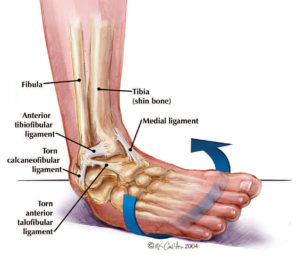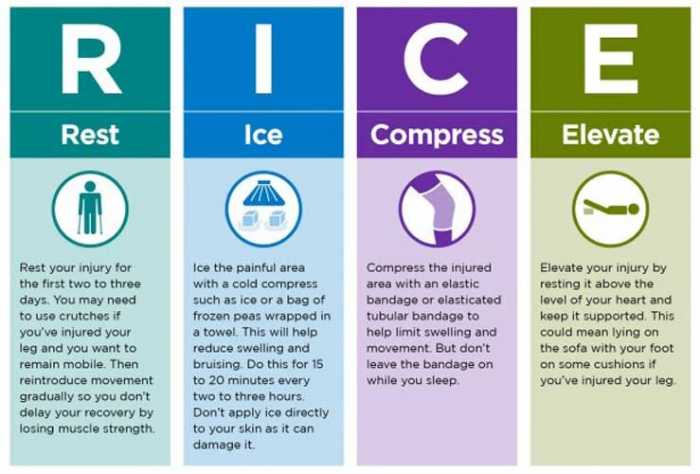Ankle Sprains: Athletes Shouldn’t Just Walk it Off
April 10 2023
An estimated 2 million ankle sprains occur each year in the US. Many athletes just walk it off, but should they? Dr. Bartholomew discusses symptoms and treatment options.
OVERVIEW
- Determining severity of sprain
- Symptoms
- Treatment
- Rehabilitation

Athletes come in all different shapes and sizes. An athlete can be any age, gender, and level of current physical fitness. It doesn’t matter how wealthy you are, if you do sports professionally or casually, if you run for your health or because you love the feeling of the wind on your face. Athletes come from all walks of life and work out for all sorts of personal or professional reasons. However, the one thing that binds almost all athletes together is a spirit of determination. We believe in the adage “When the going gets tough, the tough get going”. You keep working through the burn, you get in the zone, push your limits, and get stronger and faster every day. For most athletes, it’s not the exercise that’s hard, it’s stopping before you’re ready.
Unfortunately, that’s exactly what an injury does, and they happen to everyone. Sports injuries are the type that are often nobody’s fault.
Maybe your wrist twisted right before that surprisingly painful tennis swing or there was a small rock under your shoe when your foot landed causing the ankle to turn. No matter what the cause, when you feel an unusual pain during your workout, it’s time to stop and assess the situation.
While there is a surprisingly large variety of possible sports injuries that can happen in a moment of imperfect movement, sprained ankles sit reliably at the top of the chart as the most common sports injury. Part of the reason for this is because it can happen to anyone, even someone who never works out, because all requires is stepping down the wrong way once. Too much pressure on your ankle or turning your ankle while putting weight on it is all too easy, especially in a situation with a variable terrain or where you’re working out to exhaustion and losing perfect form somewhere along the way. If any point during your past or future workout routines, your foot lands wrong and your ankle hurts sharply in response, chances are you have just sprained your ankle.
The reason ankle sprains are so easy to get is that a sprain is simply the result of stretching your ankle tendon too far, often in a direction it wasn’t meant to stretch. This over-extension causes small to medium tears in the tendon tissue, weakening it an causing an increasing amount of pain depending on the extent of the damage. This is why it’s difficult and painful to walk on a sprained ankle and why they tend to swell up so much.
The Temptation to “Walk it Off”
“Walk it off” is a phrase we hear a lot in sports and athletic pursuits. You may have heard it from a personal trainer, from movies about exercising and sports, and even from your coaches. The concept of walking off a minor injury is deeply rooted in the athlete’s mentality. You are an unstoppable exercise machine and no little bump or scrape is going to slow you down. The fact of the matter is, in many cases, this is exactly the right attitude to have. The idea of walking off a minor injury applies primarily to taking good care of your muscles and not letting little setbacks get in the way of a good workout.
Most of us starting from elementary school PE class have been taught to walk off the little things. Let’s say you’re playing soccer with a friend or running across a field and accidentally take a tumble into the turf. You come up with a few extra scrapes and bruises but otherwise are completely fine. Sure, it stings a little, but in this situation, your best course is to roll through the minor pain, disinfect any open scrapes, and take a walk to cool down your muscles correctly after a hard workout.
Not only is this often the best answer, it’s also what athletes prefer to do because who wants to give up in the middle of a great workout?
Unfortunately, while building this mentality of strength and resilience is great for continuing training after a minor bump, it can also put you at risk of making the wrong decision if an injury really is serious. Athletes would rather walk something off than admit that they’ll have to change routines and recover carefully for a few weeks. The problem is, especially with slow-swelling injuries like sprained ankle, is that you can make the issue ten times worse by stressing the torn tendon immediately after the injury.
Knowing the difference between harmless turning and a sprained ankle.
Perhaps the biggest confusion in whether or not to walk off a recent ankle injury is the ability to tell the difference between a minor ankle incident and a sprain that could get worse. If every time your ankle turned wrong or over-stretches, you developed a sprain, it would be easy to identify the right moments for treatment. However, not every ankle turn does result in sprain. People accidentally turn their ankles and step wrong all the time and in the vast majority of cases, it’s harmless. You correct your foot, maybe roll the ankle for a moment, and everything is fine. Mild turns can be walked off, and the key is to know the difference between a harmless ankle turn and an actual sprain.
Signs of a Sprained Ankle
- Pain
- Tenderness
- Weakness
if your ankle turns or stretches and you immediately feel an intense pain or ache, that is almost invariably a sprain rather than a normal turn. Turned ankles may ache or feel strangely stretchy for a moment but should never hurt. if you feel pain in your ankle, take a moment to sit down, remove your shoe and sock if necessary, and gently probe the painful area with your fingertips. if the ankle is tender to the touch and probing increases or creates pain, that’s a sprain that is about to swell quite badly. The next assessment is how well it can hold your weight. Carefully, using something like a bench or tree as a brace, try placing your foot flat on the ground and slowly shift your weight to it. if you feel pain or experience weakness, this is a sprain or worse and you should seek medical attention.
Necessary Treatment for a Sprained Ankle
Okay, so you can’t walk off the sprain but that doesn’t mean that you have to be completely out of commission. There are still hundreds of exercises you can do, even with the leg attached to the injured ankle, as long as you are also applying the correct recovery treatments. Ankles tend to take anywhere from two to eight weeks to heal and the process will go faster if you know what to do.
Wrap and Ice
immediately after the sprain, your first priority is to reduce swelling. This will keep your ankle more mobile and reduce the amount of tenderness that occurs. Swelling is reduced with a combination of compression through a bandage or ankle brace and steady application of ice. The best way to ice is with crushed ice in a plastic bag wrapped in a towel to give it flexibility around the ankle and protect your skin from the direct cold. Another option is a reusable fabric cold/hot pack that provides effective and safe cold and hot therapy treatment, recommended by medical professionals.
Check with a Doctor.
Next, make sure to have your ankle examined by a medical professional. They will be able to tell you how bad the sprain actually is and this allows them to check for a more serious condition just in case. In most cases, your doctor will reassure you that it’s a perfectly normal sprain that requires the usual sports recovery treatments.
Rice for Weeks
In a few weeks to come, the way you treat your ankle will make a big difference in how soon you can get back onto the field. The most common and easy to implements recovery technique is known as RICE which stands for Rest, Ice (or Heat), Compression, and Elevation. This basically comes down to mean that you should stay off the foot, treat it with temperature based on the swelling situation, wrap it tightly for support and swelling control, and keep it above your heart whenever possible to promote blood flow.
One of the most important details about the RICE method is that you should use ice while the ankle is still trying to swell and heat once the swelling dies down to promote healing through increased blood flow and muscle relaxation.
Getting Around with a Sprained Ankle
Finally, even though your ankle is out of commission for a while, this doesn’t mean that you are required to give up your daily activities and become a couch potato for several weeks.
Determined athletes have several ways to keep the ankle safe and in recover while still maintaining a rigorous exercise routine and doing daily tasks like going to the office or grocery shopping.
 The key to a safe yet active sprained ankle recover is almost always having the right brace. You need something that can compress comfortably to combat swelling, protect the ankle from impacts that could cause additional damage during the recover process, and provide enough support that if you had to stand on two feet for a moment, it wouldn’t immediately re-tear the healing tendon. Feel free to consult with your trainer, coach, or medical advisor and try a few braces to find the right one for you.
The key to a safe yet active sprained ankle recover is almost always having the right brace. You need something that can compress comfortably to combat swelling, protect the ankle from impacts that could cause additional damage during the recover process, and provide enough support that if you had to stand on two feet for a moment, it wouldn’t immediately re-tear the healing tendon. Feel free to consult with your trainer, coach, or medical advisor and try a few braces to find the right one for you.
Do you have an ankle sprain? You can contact Dr. Bartholomew’s office at (239) 430-3668 (FOOT) or visit NaplesPodiatrist.com to schedule an examination.
Dr. Patrick Bartholomew is a podiatric physician and surgeon practicing in Southwest Florida. Board Certified: American Board of Foot and Ankle Surgery.
—————–



 Fax: (239) 692-9436
Fax: (239) 692-9436 Tel: 239-430-3668
Tel: 239-430-3668


